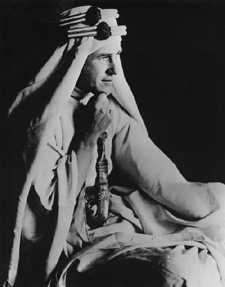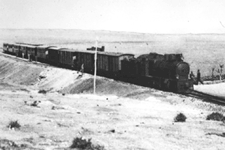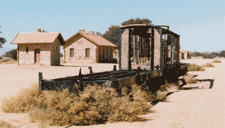
An Article from the July 2003 JOM: A Hypertext-Enhanced Article
 |
TMS
ONLINE | TMS
PUBLICATIONS | SITE
MAP An Article from the July 2003 JOM: A Hypertext-Enhanced Article |
|
|
|
|
Louise Dean is with Westmoreland Mechanical Testing & Research.
|
Exploring traditional, innovative, and revolutionary issues in the minerals,
metals, and materials fields.
|
| OUR LATEST ISSUE |
|
|
|

|
|
Figure 1. Thomas E. Lawrence. Photo courtesy of the Imperial War Museum, ref. Q46094. |
| Over the last 40 years, there has been a discernible increase in the number of scholars who have focused their research on early industrial organizations, a field of study that has come to be known as Archaeotechnology. Archaeologists have conducted fieldwork geared to the study of ancient technologies in a cultural context and have drawn on the laboratory analyses developed by materials scientists as one portion of their interpretive program. Papers for this department are solicited and/or reviewed by Michael Notis, a professor and director of the Archaeometallurgy Laboratory (www.Lehigh.edu/~inarcmet) at Lehigh University.
|
 |
Figure 2a. The Hijaz railway in operation. Photo courtesy of the Imperial War Museum, ref. Q59650. |
 |
Figure 2b. The modern relics of the Hijaz railway. Photo by Galen R. Frysinger; www.galenFrysinger.com. |
The real “Lawrence of Arabia,” was Thomas Edward Lawrence (1888–1935), a British archeologist (Figure 1). His work took him to Carchemish in the Arab part of the Ottoman Empire, which was soon to be a dangerous place due to the imminent onset of World War I. Prior to World War I, the Hijaz railroad had been built in this region for the Turks by German engineers using 5,000 multi-racial workers. The chief engineer was Pasha Heinrich August Meissner, a civil engineer born in Germany. The railroad was funded entirely by subscriptions starting in 1901 from Muslims throughout the world. The advertised intention was to link Damascus to Mecca to facilitate the sacred trip to Mecca. However, the rail was only laid as far as Medina (1,320 kilometers of track) as Bedouin tribes would not provide access to the remaining region.1 Still, prior to the railroad, the trip from Damascus to Medina would take two months by camel caravan and with the train took only 55 hours. Beginning its regular service in 1913, the line transported as many as 500 passengers daily. No one knew that World War I would erupt the next year, ousting the Ottoman Empire from Arab lands after 400 years of rule. The rail lines were also used to facilitate the movement of the Turkish military and to provide greater centralization to the ailing Ottoman Empire.
The track of the Hijaz railway became the theater of a critical military engagement led by a British officer and explosives expert, Lawrence of Arabia. The subject of an epic film by the same name in the mid-1960s, Lawrence of Arabia became a British intelligence officer in 1914 and spent much of his energies in 1917 and 1918 blowing up sections of this rail. As an archeologist in the region, he had learned the customs of the Arabs and there was mutual respect between them. Lawrence led attacks with the Arab guerillas against the Turks of the Ottoman Empire, sabotaging the railway that provided them with food, water, and military supplies. He avoided completely severing the line so as to draw Turkish concentration away from the main battlefronts. As a rule, Lawrence was so accurate at dynamiting train engines that the seats were sold accordingly— the safer seats in the back of the trains were said to have sold for five times more than the more risky ones in the front, near the engine. Figures 2a and 2b show the Hijaz railway in operation as well as its modern-day remnants. The eventual mutilation of the railway allowed the British Navy to have access to every important Red Sea port and helped to end World War I.
The chemistry of the rail section was determined in order to identify the steelmaking process used (Table I). No deoxidizers are present in the sample, and the nitrogen and sulfur contents are high. The largest steel producers in Germany in 1890 (now Volklinger and Neunkirchen Iron and Steel Works of Saarstahl AG) had produced steel track since 1845 and put Thomas steelmaking process plants into operation in 1881 and 1892. Prior to the Thomas process, puddling iron was produced where the molten pig iron from the blast furnace was physically stirred to reduce the carbon content. The Thomas process, which is essentially the basic Bessemer process where air is blown through the melt to remove carbon and silicon from the pig iron, was far superior in quality and cost to puddling iron. It allowed the use of high-phosphorus iron from high-phosphorus iron ores. The Thomas process differed from the acid Bessemer as the converter was lined with calcined dolomite and a lime slag was used. The basic slag removes the phosphorus and some of the sulfur from the heat. The Thomas process removes phosphorus from the melt because of the high iron-oxide content in the slag and oxygen in the melt, but the phosphorus oxidation does not occur until all the carbon is oxidized. The iron ore needed to have a high phosphorus content (~2%) to produce enough heat. The ores available to the largest German iron and steel mill were phosphorus-rich minette ores from the mines in Lorraine. These ores also had high sulfur contents. The inverse conditions favor sulfur removal from phosphorus removal, so little sulfur was removed from a Thomas process heat. Table I shows that the melt was low in phosphorus and high in sulfur.
|
|
|||||||
|
|
C*
|
Mn
|
P
|
S*
|
|||
| Hijaz rail |
|
|
|
|
|
|
|
|
*Leco techniques used and OES for remaining elements |
|||||||
The Thomas process was readily adopted in Germany and France, as those countries only possessed higher-phosphorus iron ores. This process advanced German steel from being a low-quality puddling iron source (with high phosphorus) to higher-quality steel producer, leading to Germany’s flourishing steel industry during the war.
Open-hearth furnaces were introduced later and went into operation in 1915 and 1916 at these two mills. The final composition of a grade produced by the Thomas process or the open-hearth process would be the same, except in the Thomas process the nitrogen content would be on the order of 100 ppm versus 30–50 ppm for the open hearth. Also, the open hearth would not remove phosphorus, which existed in high levels in the minette ores. The higher nitrogen content would make the steel stronger with less ductility. The low phosphorus and high nitrogen content point to steelmaking by the Thomas process.
It is significant that the rail did not contain any elements added to deoxidize the steel. The silicon content was very low and insufficient to kill the heat, such that the rail would be expected to exhibit holes and porous sections.
Perhaps at the time this steel was produced, deoxidation was not performed. In fact, as recently as 1964, ASTM did not require deoxidation of smaller section rail joint bars (just as the Hijaz rail size)—ASTM A 4-64 required the steel have at least 0.03 carbon and 0.05 maximum phosphorus (but if the producer wanted to check the phosphorus content, it could be 25% higher than 0.05 and still meet the specification).2
Macrostructure and Microstructure
The rail was macroetched to reveal any gross porosity, surface seams, laps, or piping (Figure 3). Macroscopically, none of these defects was detected with just slight segregation noted.
The microstructure was viewed optically and on the scanning electronmicroscope (SEM). Optically, the structure is clearly ferrite and pearlite. The numerous particles obvious in the ferrite are MnS inclusions (Figure 4).
On the SEM, it was possible to identify the particles as MnS inclusions and also detect the phosphorus concentration. Phosphorus dissolves predominantly in ferrite3 and can be seen throughout the structure (Figure 5).
The SEM examination also found that porosity existed in large areas (Figure 6). This was expected from the low level of deoxidizing elements andthe relatively low carbon content.
|
|
|
|
||
|
Figure 3. A macroetched and micropolished rail section, with locations of hardness traverses (2% Nital). |
Figure 4. The microstructure of the rail showing ferrite, pearlite, and numerous MnS inclusions (2% Nital). |
Figure 5. The structure of the rail and concentration of MnS (green) and P (pink). |
||
|
|
|
|
Hardness Profile
There were four hardness traverses taken from four different locations (the locations shown in Figure 3) in the cross-section of the rail (Figure 7). The hardness at the top of the rail (A) was higher than the other locations. Strain and work-hardening lines were seen at this top surface, likely the result of the engine and train car wear during use (Figure 8). The etchants used were picral and sodium metabisulfite in a two-stage tint step etching process to delineate the interface between the ferrite (beige) and pearlite (dark red regions).4 The strain and work-hardening lines could be caused by wheels spinning on the track. It has been reported that wheel spinning could occur when traction was poor and that sand was used to improve the traction.5
|
|
|
|
||
|
Figure 6. A SEM image of the rail showing porosity in the structure. |
Figure 7. The hardness of the Hijaz rail, from the surface. |
Figure 8. The microstructure of top of the rail showing strain lines from work hardening (Picral/sodium metabisulfite). |
||
|
|
|
|
Lawrence of Arabia was an archeologist and one of the heroes of World War I, and it is possible he would be interested in the investigation of the ruins he left behind.
References
1. M. Yardley, T.E. Lawrence (New York: Stein and Day
Publishers, 1987).
2. ASTM Standard, Part 4 (Philadelphia, PA: ASTM,
1967).
3. E.C. Bain and H.W. Paxton, Alloying Elements in
Steel (Metals Park, OH: ASM, 1966).
4. A.K. De, J.G. Speer, and D.K. Matlock, Advanced
Materials and Processes, 161 (2) (2003), pp. 27–30.
5. Fractography, Metals Handbook, vol.12 (Metals
Park, OH: ASM, 1987) p.115.
For more information, contact Louise Dean, Westmoreland Mechanical Testing & Research, P.O. Box 388, Youngstown, PA 15696-0388; (724) 537-3131; e-mail louise@stargate.net.
Direct questions about this or any other JOM page to jom@tms.org.
| Search | TMS Document Center | Subscriptions | Other Hypertext Articles | JOM | TMS OnLine |
|---|